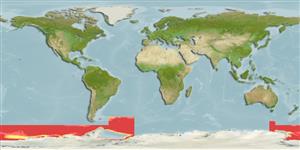Environment: milieu / climate zone / depth range / distribution range
Ökologie
seewasser; tiefenbereich 10 - 1600 m. Polar; 50°S - 78°S, 143°E - 19°W (Ref. 1371)
Southern Ocean: coasts of Antarctic Peninsula, Scotia Sea (South Georgia, South Sandwich, South Orkney and South Shetland islands), Victoria Land and Ross Sea.
Length at first maturity / Size / Gewicht / Alter
Maturity: Lm 27.5, range 23 - 32 cm
Max length : 35.0 cm TL Männchen/unbestimmt; (Ref. 1371); common length : 27.0 cm TL Männchen/unbestimmt; (Ref. 1371)
Rückenflossenstacheln (insgesamt) : 0; Rückenflossenweichstrahlen (insgesamt) : 135; Afterflossenstacheln: 0; Afterflossenweichstrahlen: 106; Wirbelzahl: 69. Dorsal filament variable in length, but never longer than twice the eye diameter. Outer rays of the pelvic fins filamentous, of unequal lengths. Lateral line arched above the pectoral fin, extending to slightly beyond the pectoral fin tips. Color is uniform gray-brown, with iridescent hues.
Dwells in continental and insular shelves and slopes. Feeds on zooplankton. Synchronous spawner (Ref. 50743).
Cohen, D.M., T. Inada, T. Iwamoto and N. Scialabba, 1990. FAO species catalogue. Vol. 10. Gadiform fishes of the world (Order Gadiformes). An annotated and illustrated catalogue of cods, hakes, grenadiers and other gadiform fishes known to date. FAO Fish. Synop. 125(10). Rome: FAO. 442 p. (Ref. 1371)
IUCN Rote Liste Status (Ref. 130435: Version 2024-2)
Bedrohung für Menschen
Harmless
Nutzung durch Menschen
Fischereien: weniger kommerziell
Tools
Zusatzinformationen
Download XML
Internet Quellen
Estimates based on models
Preferred temperature (Ref.
123201): -1.9 - 1.6, mean -0.7 °C (based on 751 cells).
Phylogenetic diversity index (Ref.
82804): PD
50 = 0.5059 [Uniqueness, from 0.5 = low to 2.0 = high].
Bayesian length-weight: a=0.00437 (0.00171 - 0.01116), b=3.11 (2.89 - 3.33), in cm total length, based on LWR estimates for this (Sub)family-body shape (Ref.
93245).
Trophic level (Ref.
69278): 3.4 ±0.4 se; based on diet studies.
Generation time: 4.2 ( na - na) years. Estimated as median ln(3)/K based on 1
growth studies.
Widerstandsfähigkeit (Ref.
120179): mittel, Verdopplung der Population dauert 1,4 - 4,4 Jahre. (tm=4; Fec = 85,810).
Fishing Vulnerability (Ref.
59153): Moderate vulnerability (41 of 100).
Climate Vulnerability (Ref.
125649): High vulnerability (62 of 100).
Nutrients (Ref.
124155): Calcium = 28.6 [13.1, 61.2] mg/100g; Iron = 0.478 [0.243, 0.999] mg/100g; Protein = 16.8 [15.3, 18.2] %; Omega3 = 0.265 [0.119, 0.570] g/100g; Selenium = 17.6 [5.9, 46.3] μg/100g; VitaminA = 14 [3, 74] μg/100g; Zinc = 0.526 [0.336, 0.834] mg/100g (wet weight);
